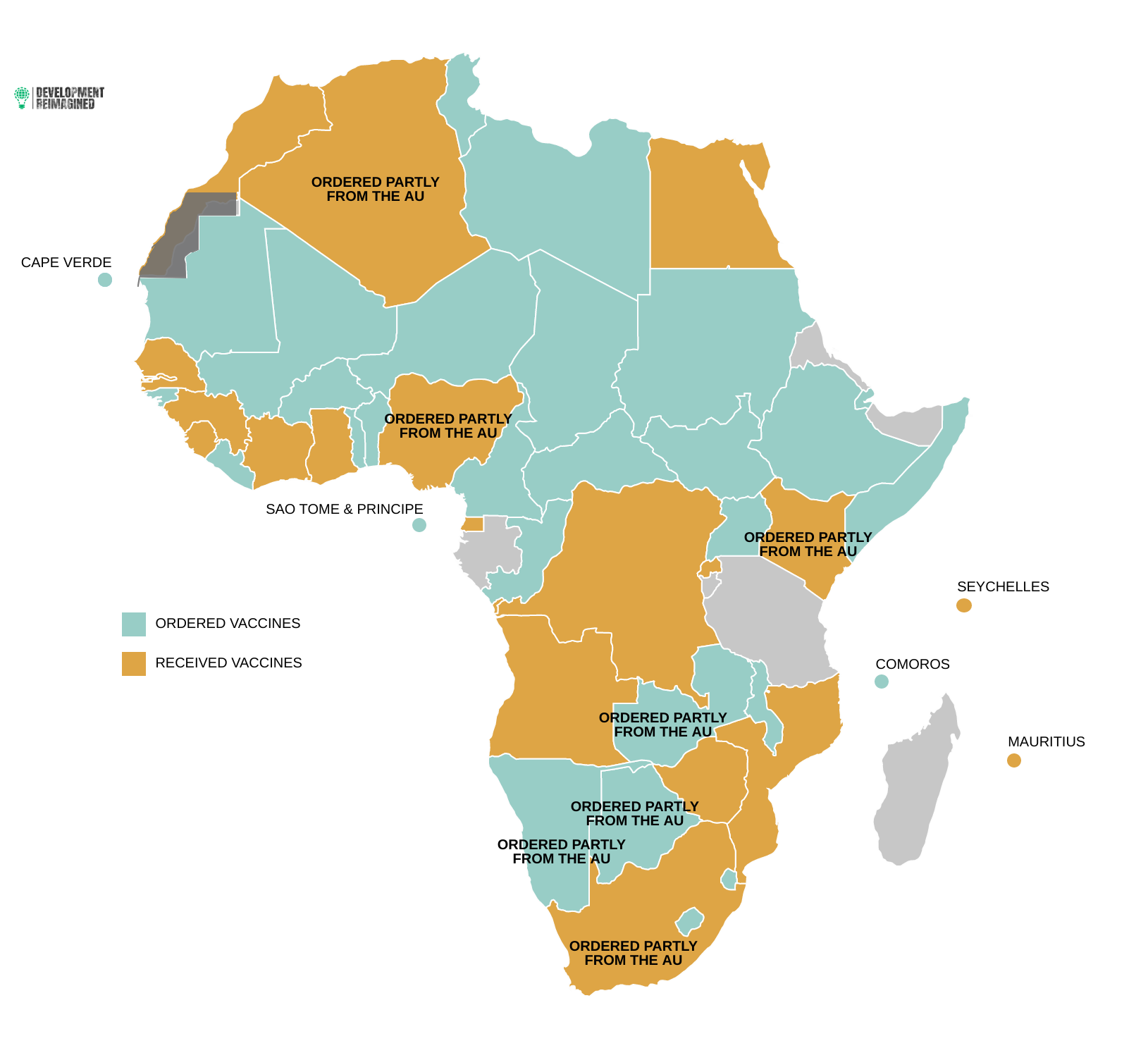Updated Every Month
1 billion vaccine doses have been ordered by African countries and the African Union, but only 1.5% of these have been delivered so far. That’s not a headline you will read anywhere else. The news elsewhere is typically dominated either by photos of planes arriving with vaccines from COVAX or China, with the aim of demonstrating global “solidarity” with African countries, or with painful messages of African nations falling behind.
The real picture is somewhere in-between, but importantly the real picture has to centre African countries and agency – not a case of charity, nor poor governance, at least for the vast majority of countries.
So what is that real picture?
Over the past few months we have seen African governments continue to work to get vaccines onto the continent. Three months ago – only 8 countries had ordered vaccines. This has gradually ramped up, and this month, 48 countries have placed orders. Of these countries, 31 countries have announced their plans for vaccine rollout – with at least 3 announcing explicitly they will provide vaccines for free to their citizens – Namibia, Morocco and Rwanda. This is excellent progress by African governments overall, and good for African people hoping to increase working, learning, travelling and interacting with each-other post-COVID19.
Indeed, the remaining seven countries – Burundi, Eritrea, Eswatini, Gabon, Madagascar, Sahrawi Republic, and Tanzania – are now the outliers.
That said, the increase in actual doses ordered has not been particularly strong during February – a rise of around 35 million doses. More progress has been made on deliveries and therefore vaccine rollout. Last month, only 7 countries had taken delivery of 9 million doses. This month, a total 20 countries have received 15.7 million doses – a mix of low-income and middle-income countries.
This explains all those plane photo-ops. But unfortunately it also accounts for just 1.5% of all doses ordered – or to put it differently, just 0.6% of Africa’s entire population. It’s clear that faster progress needs to be made – which in turn depends on how high African nations rank in terms of manufacturer’s decisions to press “send”.
Why prioritise African countries? Well, we see in our data too that African countries are continuing to use social distancing measures, continuing to test (over 36 million tests have been done on the continent so far), while planning the vaccine rollouts. Many are tailoring vaccine rollouts to their demographics as well as economic challenges they have faced over COVID19 – for example Mauritius, Seychelles and Cabo Verde are prioritising vaccinating tourism workers as well as medical workers and the vulnerable. 12 countries are prioritising teachers, religious leaders and politicians – given their central roles in society and exposure to other citizens. Ghana is prioritising essential workers – who deal with utilities such as water, electricity and food delivery. Libya is prioritising refugees.
All these are not indications of a helpless continent. They are indications of competence and decisiveness, held back by low financial capacity and low local manufacturing capability. For instance, having already set aside a calculated total $68 billion for the health and economic impacts of COVID19 in 2020, most African countries continue to face a lack of fiscal space to pay for vaccines, despite the Debt Service Suspension Initiative (DSSI) agreed from May 2020 and partially agreed in 2021… The finance to continue to subsidise lockdowns is not there either.
Free vaccines – donated from COVAX, as well as by organisations and other countries – will therefore be helpful. These are slowly coming in. In addition to COVAX, a total 15.2 million doses have been announced as being given for free to African countries so far – 77% of which are from MTN – an African telecoms company, 17% from China, and 4% from India. Senegal has been the first African countries to support others – donating 10% of the vaccines it received and paid for from China to Guinea-Bissau and Gambia. What neighbourliness!
However, free vaccines will not be sustainable into the long-term. Faster delivery now is key, as is scaling up local manufacturing. As we mentioned last month, only three countries in Africa are planning to manufacture international vaccines – Morocco (the Chinese vaccine), Egypt (Russian vaccine), and South Africa (US Johnson & Johnson vaccine). More needs to be done to get this production moving fast, and widened further to other countries.
To review the data yourself, and reflect on what this means for the rest of 2021 and beyond, check out the graphics and numbers below, and let us know what you’d like to find out next month.

*** The End***
To find out how Development Reimagined can help you, your organisation or Government during the COVID-19 outbreak please email the team at clients@developmentreimagined.com .
Special thanks go to Rosie Wigmore, Sophia Kladaki, Joana Cobbinah, Rosie Flowers, and Jing Cai for their work on the graphic and collecting/analysing the underlying data.
The data was collated from a range of sources including: government websites and media reports, the IMF policy tracker; Africa CDC and Worldometer. Our methodology is entirely in-house, based on analysis of vaccine, testing, spending, social distancing, income categories and other trends.
If you spot any gaps or have any enquiries, please send your feedback to us at team@developmentreimagined.com, we will aim to respond asap.
March 2021


